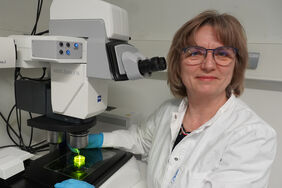Dr. Birgit Perner, a research associate at the Leibniz Institute for Aging Research – Fritz Lipmann Institute (FLI), can hardly believe it herself. She has now been working at the institute for 25 years – an anniversary like this is rare in the scientific world. When she joined the FLI in February 1999, the institute was still called the Institute for Molecular Biotechnology (IMB). The research focus has since changed (,) towards biomedical aging research. Dr. Birgit Perner was always convinced that she would be able to shape her professional future as a scientist at our research institute and has (therefore) successfully faced all the challenges of the last 25 years.
A brief overview of her interesting (professional) life: Immediately after school, the native of Saxony-Anhalt came to Jena in 1983 to study biology, which she successfully completed, leading to her doctoral degree. She then worked at the university, first in microbiology and then in biophysics. There Dr. Birgit Perner learned about laser scanning microscopy, which ultimately led her to Prof. Karl-Otto Greulich's “Single Cell and Single Molecule Technology” working group at the IMB. In 2005 she moved to Prof. Christoph Englert, who was then establishing his “Molecular Genetics” research group, and worked on new research fields such as working with fish models. Since then, Dr. Birgit Perner has worked in the research group as an experienced scientist and zebrafish expert, participating in various projects and contributing in numerous publications.
The 59-year-old has also been part of the Core Facility Imaging team at the institute for eight years. The biologist works in both the scientific laboratory and the microscopy service facility. “It’s the mix that I like so much about my work,” she explains. It is this combination of activities in both areas that enrich each other, says Dr. Birgit Perner. "Through my work in the laboratory, I am closely involved in the Englert research group. By using a wide variety of microscopic techniques, I also get to know projects from other research groups - both are very varied and exciting." Her favorite methods include histochemistry and in-situ Hybridization. These procedures make it possible to mark specific target structures in cells.
The microscopy expert is particularly proud of her pioneering work in testing a light sheet microscope that was new at the time. As part of a cooperation with ZEISS, the experienced employee shared her practical experience and the resulting modifications requests allowing larger objects to be examined three-dimensionally with the microscope. Since then, the FLI has also acquired such a light sheet microscope. With its help, Dr. Birgit Perner, for example, successfully visualized senescent cells in a transparent fish model last year, generated in the Englert research group. Dr. Birgit Perner appreciates the friendly, open atmosphere at the institute, the collegial and open-minded interaction with one another, and working with both young people and colleagues of the same age. “We are also very well equipped, and you receive support from many sources; for example I was able to work part-time when the children were still little,” emphasizes the mother of two. “I always felt comfortable at the institute and was fortunate to engage in activities that suited me,” is the summary of the FLI employee, who has always remained loyal to the city of Jena.
We wish Dr. Birgit Perner further fulfilled professional years with interesting projects at the FLI and thank her for the work she has done so far.









